Almost every U.S. state has venomous snake species, but some have more lethal snakes than others. Texas has the second most venomous snakes of any state in the United States of America.
The most venomous snake in Texas is the coral snake. That’s followed by Mojave rattlesnakes, which have the most potent venom of any rattlesnake. Texas is also home to the western diamondback rattlesnake and the timber rattlesnake, both of which are deadly.
We’ll be looking at Texas’s most venomous snake species. We’ll discuss each snake’s preferred habitat and appearance, so that you can easily recognize them in the wild. We’ll also look at the venom toxicity of each snake, and share some interesting bite facts.
Venomous Snakes Found in Texas
Texas is home to many species of snake. If you venture out during snake season, you may come across one, even in your backyard.
Of these, the vast majority – including the Texas brown snake, milk snake, and gopher snake – are non-venomous. Others, such as garter snakes and hognose snakes, have very mild venom that doesn’t harm humans.
However, there are four kinds of venomous snake in Texas which are considered highly dangerous to humans. These include:
- Rattlesnakes, otherwise known as “rattlers.” Recognizable by a segmented rattle at the ends of their tails, rattlesnakes are most common in rocky arid and semi-arid habitats.
- Copperheads (dry-land moccasins). These snakes are pit vipers, like rattlesnakes, and share many of the same visual characteristics.
- Cottonmouths (water moccasins). These semi-aquatic venomous snakes are often found in water, and are related to copperheads.
- Coral snakes. These highly venomous elapids belong to the same family as cobras. They’re shy snakes and not very aggressive.
According to the Centers for Disease Control and Prevention, around 5 people in the United States die each year from snake bites.
Texas Coral Snake (Micrurus Tener)
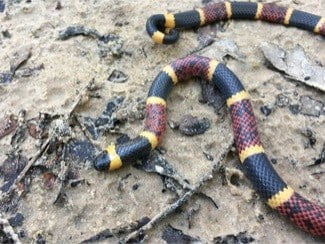
The most potent venom is that of the coral snake. These snakes are elapids, belonging to the same family as cobras and mambas.
There are three species in the U.S., but the only one found in the Lone Star State is the Texas coral snake.
Appearance
Most venomous snakes in the U.S. are pit vipers. Being elapids, coral snakes look very different.
They have smooth scales and small, narrow, oval-shaped heads with round eyes. Texas coral snakes usually reach between 2 and 4 feet in length, and their bodies are quite thin.
They are brightly colored, with wide red and black bands separated by thin yellow rings. People often mistake them for kingsnakes and milk snakes.
Habitat
Texas coral snakes can be found mostly in the southeastern part of the state. They are found no further west than Pecos County, and no further north than Lamar County.
You typically won’t find coral snakes in dry or desert areas as they prefer environments with lots of vegetation, such as forests.
Bite
Bites from Texas coral snakes are very rare as they are nocturnal and shy. They spend most of their time hiding in leaf piles and burrows. They are usually reluctant to bite, and their fangs are quite small.
However, coral snake venom packs a punch. It contains potent neurotoxins which can cause paralysis of the respiratory system and even death. Fortunately, death is rare due to medical intervention (antivenom).
Mojave Rattlesnake (Crotalus Scutulatus)
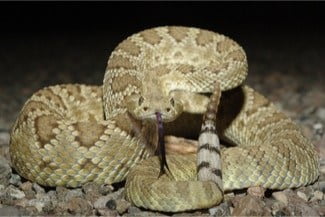
The second most venomous snake found in Texas is the Mojave rattlesnake. Of all the rattlesnakes in the world, the Mojave possesses the most potent venom.
Appearance
The Mojave rattlesnake is a heavy-bodied snake, rarely growing longer than 3 feet in length.
Its main body color is yellowish, tan or brown, sometimes with a greenish tint (giving rise to the nickname “Mojave green”). It has a series of brown, light-edged blotches running down its body, which can be diamond-shaped or saddle-shaped. There is black and white banding on the tail, at the base of the rattle.
Mojave rattlesnakes have wide, triangular-shaped heads, and thin necks. They have elliptical (slit-like) pupils, and heavily keeled (ridged) scales.
Habitat
Though it gets its name from the Mojave Desert in California and Nevada, it can also be found in Texas. Its range is restricted to the Trans-Pecos region in the far west of the state.
Mojaves do not often venture into populated areas; they prefer flat, rocky areas with sparse vegetation. However, they’re also found in grasslands.
Bite
Mojave venom is extremely dangerous. It contains neurotoxins which can cause vision abnormalities, difficulty speaking, and breathing.
Fortunately, CroFab antivenin (available in most hospitals) effectively deals with these effects. With prompt medical attention, death is unlikely. The most recent death from a Mojave bite was back in 2007.
Western Diamondback Rattlesnake (Crotalus Atrox)
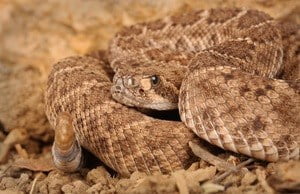
The western diamondback rattlesnake causes the largest number of snake bites in the United States.
This is due to its highly defensive disposition, and tendency to strike when approached.
Appearance
Western diamondback rattlesnakes look quite similar to Mojaves. They are usually tan to brown, with darker diamond-shaped patches along their bodies.
Their tail has black and white bands, though the black bands are much thicker than in the Mojave rattlesnake. Like all rattlesnakes, they are heavy-bodied and have wide heads.
They are among the largest species of rattlesnake, commonly growing to 5 feet long.
Habitat
Western diamondbacks can be found throughout the vast majority of Texas, from Dallam County in the north to Cameron in the south. It is found as far west as El Paso and as far east as Harris County.
Western diamondbacks enjoy a diverse range of habitats, including forests, deserts and desert-scrub, grassland and rocky areas. They can even be found in yards, or anywhere with an abundance of small mammals for them to prey on.
Bite
Bites from western diamondback rattlesnakes are very common – hundreds happen each year in the United States. This is because these snakes are not afraid to stand their ground when approached, and tend to strike at the slightest threat.
Their venom contains hemotoxins which destroy blood cells, resulting in massive internal bleeding. Again, CroFab antivenin almost always prevents death.
Timber Rattlesnake (Crotalus Hhorridus)
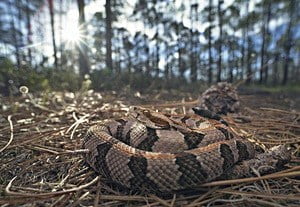
Timber rattlesnakes are one of the most common rattlesnakes across the U.S. They can be found in the majority of the eastern states, including Texas, where they are a protected species.
Because of their abundance, timber rattlesnakes are responsible for the most snake bite-related deaths in the US, along with eastern and western diamondbacks.
Appearance
Timber rattlesnakes are also known as banded rattlesnakes. They are pale yellowish-brown in color, with dark brown or black zig-zag bands (horizontal stripes).
Some specimens have a single orange-brown stripe running down the middle of their back. They have a black tail, ending in a rattle. Timber rattlesnakes may reach up to 5 feet in length.
Habitat
Found in the eastern quarter of Texas, no farther west than Eastland County, timber rattlesnakes are usually found in wooded areas. Though they are not aquatic snakes, timber rattlers prefer wetter habitats, and can often be spotted along riverbanks.
Bite
As with all rattlesnakes, timber rattlesnakes have a nasty bite. Their venom is not as potent as diamondback or Mojave venom, but because they produce a high venom yield, bites are still regarded as very serious.
Different specimens produce different types of venom, which may contain neurotoxins, or may cause internal bleeding. CroFab antivenin is effective against bites.
Massasauga Rattlesnake (Sistrurus Catenatus)
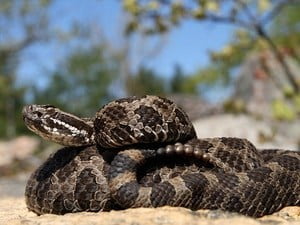
Massasauga’s most poisonous snakes are rattlesnakes, but they differ from most other species because they are part of a separate genus (Sistrurus rather than Crotalus).
They are smaller than most Crotalus rattlesnakes, but this does not make them any less dangerous. They are still pit vipers and can deliver a toxic bite.
Appearance
Massasaugas are relatively small, ranging from 1.5 to 3 feet as adults. Like all rattlers, they are heavy-bodied with slit pupils.
Massasaugas are light grey to light brown, with dark brown butterfly-shaped blotches along their backs, and two or three rows of smaller blotches down the sides.
They do not have banding on the tail. The snake’s head and neck are striped.
Habitat
In Texas, two subspecies of massasauga can be found. The western massasauga can be found in northern and central Texas, in flat grassland habitats or rocky hillsides. The desert massasauga, of western and southern Texas, is only found in the grasslands.
Bite
Massasauga rattlesnakes are quite shy and reclusive. They always try to escape danger, and will only bite a predator as a last resort. However, you could still be bitten if you step on one that’s hidden away accidentally.
About 25% of bites are dry, meaning no venom is injected, according to the US Fish and Wildlife Service. Massasauga venom contains cytotoxins, which destroy tissue and cause internal bleeding. However, bites are rarely severe, and hardly ever result in death with proper medical treatment.
Prairie Rattlesnake (Crotalus Viridis)
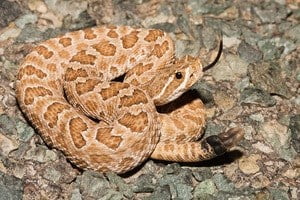
Prairie rattlesnakes are sometimes known as plains rattlesnakes, as they occur mainly in the Great Plains of North America.
They are one of the most common rattlesnakes in the United States, along with the timber rattlesnake.
Appearance
Prairie rattlesnakes usually reach a minimum of 3 feet in length as adults, with the largest specimens reaching almost 5 feet.
They are tan to light brown, with large dark brown oval-shaped blotches, outlined in white. Their tails are light brown with thin dark brown crossbands, and of course a rattle on the end.
Habitat
In Texas, the prairie rattlesnake is limited to the northwestern part of the state (the panhandle and the Trans-Pecos region).
It lives exclusively in flat prairie areas, and feeds on the animals that it finds in the grasslands, such as birds and rodents. Prairie rattlesnakes do not usually find their way into residential areas.
Bite
Like ‘most’ species of rattlers, prairie rattlesnakes are not aggressive, and prefer to retreat from danger. They will bite when cornered or stepped on.
Their venom is mildly hemotoxic and has some neurotoxic properties. Though their bites are not as serious as the other rattlesnakes we’ve discussed, medical treatment is still necessary. Antivenin is effective at remedying the effects felt from a bite.
Cottonmouth (Agkistrodon Piscivorus)

Otherwise known as water moccasins, cottonmouths are semi-aquatic pit vipers. They belong to the same subfamily as rattlesnakes, and share some physical features, although they do not have rattles on their tails.
They are often mistaken for harmless water snakes, which is a mistake that can have serious consequences.
Appearance
Cottonmouths are heavy-bodied pit vipers that can grow up to 3 feet in length. They have wide-set heads, slit-like pupils and keeled scales.
Western cottonmouths, found in Texas, are dark brown, dark grey, dark olive or black. Juveniles are lighter in color with prominent crossbands that fade with age.
The inside of their mouth is bright white, hence the nickname “cottonmouth.” When threatened, they will often pose with their mouth open in a gaping display.
Habitat
As a semi-aquatic snake, cottonmouths spend most of their time in or near the water (swamps, marshes, lakes, and rivers).
Though they breathe air, they can hold their breath while they hunt underwater for up to an hour. They reside mainly in eastern and southeastern Texas.
Bite
A bite from a cottonmouth is not as serious as a bite from a rattlesnake. Its venom is cytotoxic, meaning that it destroys bodily tissue.
Deaths are rare, but bites can occasionally lead to amputation. CroFab antivenin, normally used for rattlesnake bites, is also effective for cottonmouth bites.
Copperhead (Agkistrodon Contortrix)

Out of all of America’s most venomous snakes that pose a danger to humans, the copperhead has the least potent venom.
However, the majority of venomous snakebites in the country are attributed to copperheads, due to their abundance in the wild.
Appearance
Copperheads are pit vipers, belonging to the same genus as cottonmouths. They are probably the most instantly recognizable pit viper due to their coloration.
Their background color is pale tan to light brown, sometimes with a pinkish or orange tint. They have wide, copper-colored bands across their backs.
These markings appear hourglass-shaped on southern copperheads. As their name suggests, they have copper-colored heads and eyes.
Habitat
Copperheads can be found throughout most of Texas aside from the northernmost counties in the panhandle area, and the extreme southern counties.
They occupy a diverse range of habitats, from rocky outcrops to woodlands. They can be found near rivers and swamps, and sometimes even on farmland. The Trans-Pecos copperhead can even tolerate desert areas.
Bite
Bites from copperhead snakes are more common in the U.S. than bites from any other venomous snake. They camouflage into the forest floor and stay still when approached, meaning they are often inadvertently stepped on.
Their venom causes symptoms such as pain, swelling, vomiting, bruising and tachycardia (increased heart rate). However, a venomous bite is rarely serious enough to require antivenin treatment.
Is Killing a Snake Illegal in Texas?
If you live in a part of Texas where venomous snakes can be found, you may be tempted to kill them on sight, particularly if they are in your yard.
In the state of Texas, killing snakes is legal, unless the snake is on the list of protected species. Some snakes are rare in Texas (or endangered nationwide), and these species are subject to special laws meaning it’s illegal to kill, capture, own or sell one.
The only venomous species on this list is the timber rattlesnake.
How to Practice Snake Safety in Texas
Living in Texas means there’s a good chance that you’ll come across wild snakes on a regular basis. As some of these might be venomous, you should learn how to practice snake safety. Here’s how:
- Always assume that the snake is venomous and take no chances.
- Stay several feet away from the snake at all times. The larger the snake, the farther away you’ll have to be to stay out of strike range.
- If you are within its strike range, don’t make any sudden movements. Move slowly away from the snake until you are out of its reach.
- If the snake is on your property, call a pest management company. They’ll be able to remove it safely, with the proper equipment. To make your yard less appealing to snakes, keep the grass trimmed short and remove any piles of rocks and logs.
If bitten, call 911 straight away. Do not drive yourself to the hospital. While you’re waiting for the ambulance, clean the wound with soap and water, and keep it elevated above the heart if possible. Never suck the poison out or apply a tourniquet; this may make the problem worse.
Do not attempt to capture or kill the snake that bit you, but do try to remember what it looked like so that you can describe it to the paramedics. This will help them to figure out whether the snake was venomous, and if so, which type of antivenin to administer.

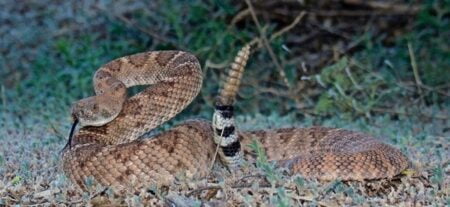
Excellent article! My husband is going hunting in Texas and was worried about snakes. I was able to show him your information, so he can identify them.